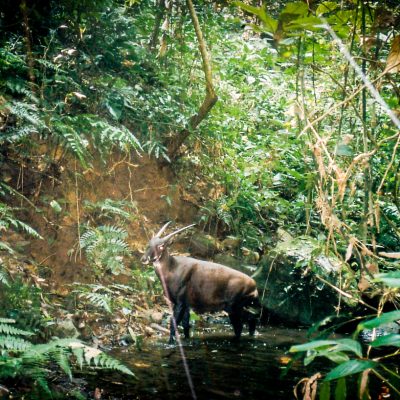Saola
The Saola
The Saola is a considered a critically endangered animal/mammal. It is also known as the Asian unicorn. The Saola was discovered in 1992 in Vietnam. They are also known to be one of the most spectacular mammals known to science in the last fifty years.

Habitat
You can find Saolas in mountains and forests typically, and they migrate and are seen more throughout wet seasons. They migrate down the mountain to low lands during the cold wintery seasons. They are typically hard to find and difficult to keep track of. The picture below shows where you are most likely to find a Saola, bordering Laos and Vietnam.

Niche
The Saola are herbivores, meaning they only eat plants. They are important to the environment because they are prey for larger animals such as tigers, which are also endangered. People in villages towns around where the Saola live also rely on them for food as well.
:max_bytes(150000):strip_icc()/Saola-58da8fcd5f9b5846835ff304.jpg)
Cause of Decline
The Saola are endangered mostly because of hunting reasoning. Poachers are on the hunt for their long beautiful horns they have on their head. There are so little of these mammals that they are special to many people.

 A picture of a man holding the skull of a Saola.
A picture of a man holding the skull of a Saola.
Why Protect the Saola?
The Saola are a major prey for other endangered species and without them they could cause other endangered animals such a tigers to become extinct. I find it sort of silly to ask the question why should we save an animal. Each and every animal is important and is so disturbing that once an animal is extinct we can never recover the animal.

Conservation Efforts
There is currently little being done in Vietnam and Laos to protect the Saola. In order to stop these critically endangered species from going extinct we have to put a stop to poachers. Another reason is to capture the remaining Saola and try to breed more in a CONSERVATIVE SAFE way.
GIS
The tools that we can use such as satellites and 3D images can help identifiy and find more of the Saolas. That way we can use the new knowledge to help keep them safe and move them away from poachers.
What can you do?
1. You can donate to the Saola Working Group, they are an activist group to help protect and save these animals.
2. Stop poachers
3. Support wildlife groups and other conservation groups.
4. Write to the leaders of Laos and Vietnam to remind them of the concern and ask for funding to help save these animals.
5. Donate to Global Wildlife Conservation.
The Saola is a considered a critically endangered animal/mammal. It is also known as the Asian unicorn. The Saola was discovered in 1992 in Vietnam. They are also known to be one of the most spectacular mammals known to science in the last fifty years.

Habitat
You can find Saolas in mountains and forests typically, and they migrate and are seen more throughout wet seasons. They migrate down the mountain to low lands during the cold wintery seasons. They are typically hard to find and difficult to keep track of. The picture below shows where you are most likely to find a Saola, bordering Laos and Vietnam.
Niche
The Saola are herbivores, meaning they only eat plants. They are important to the environment because they are prey for larger animals such as tigers, which are also endangered. People in villages towns around where the Saola live also rely on them for food as well.
:max_bytes(150000):strip_icc()/Saola-58da8fcd5f9b5846835ff304.jpg)
Cause of Decline
The Saola are endangered mostly because of hunting reasoning. Poachers are on the hunt for their long beautiful horns they have on their head. There are so little of these mammals that they are special to many people.

Why Protect the Saola?
The Saola are a major prey for other endangered species and without them they could cause other endangered animals such a tigers to become extinct. I find it sort of silly to ask the question why should we save an animal. Each and every animal is important and is so disturbing that once an animal is extinct we can never recover the animal.
Conservation Efforts
There is currently little being done in Vietnam and Laos to protect the Saola. In order to stop these critically endangered species from going extinct we have to put a stop to poachers. Another reason is to capture the remaining Saola and try to breed more in a CONSERVATIVE SAFE way.
GIS
The tools that we can use such as satellites and 3D images can help identifiy and find more of the Saolas. That way we can use the new knowledge to help keep them safe and move them away from poachers.
What can you do?
1. You can donate to the Saola Working Group, they are an activist group to help protect and save these animals.
2. Stop poachers
3. Support wildlife groups and other conservation groups.
4. Write to the leaders of Laos and Vietnam to remind them of the concern and ask for funding to help save these animals.
5. Donate to Global Wildlife Conservation.
Comments
Post a Comment